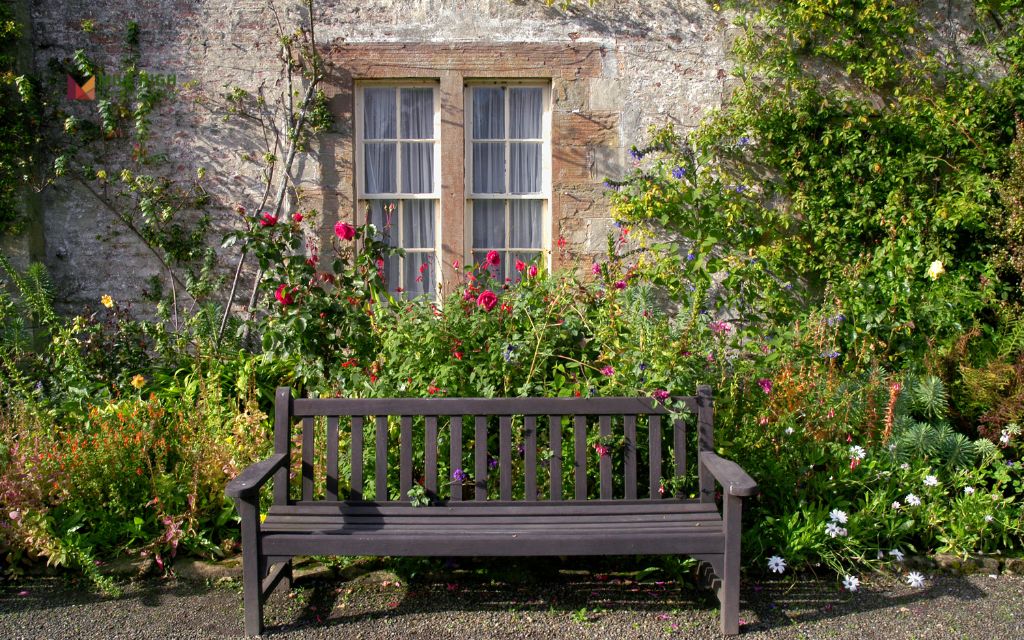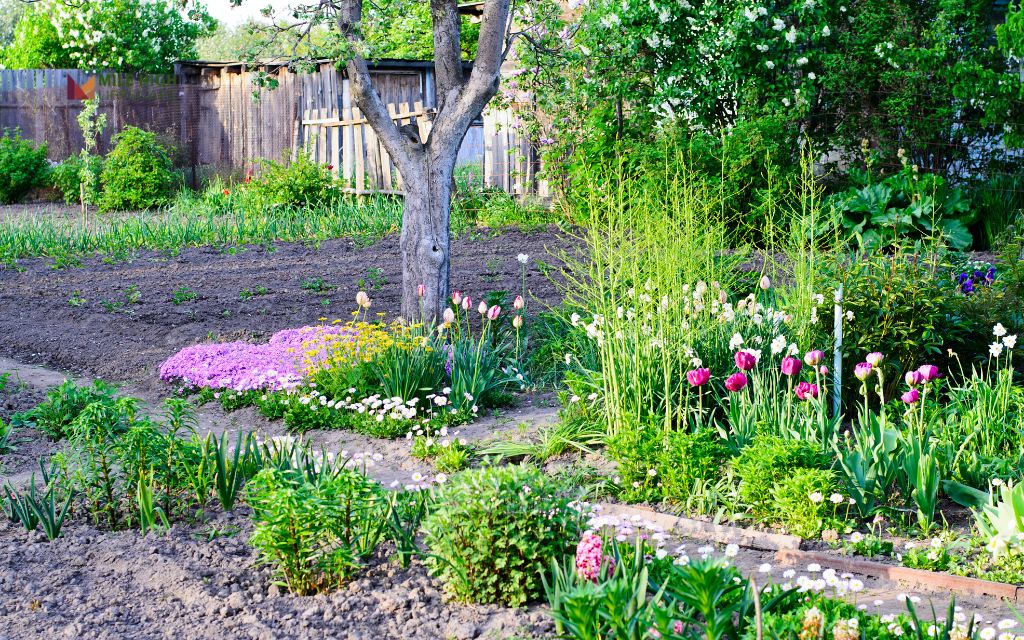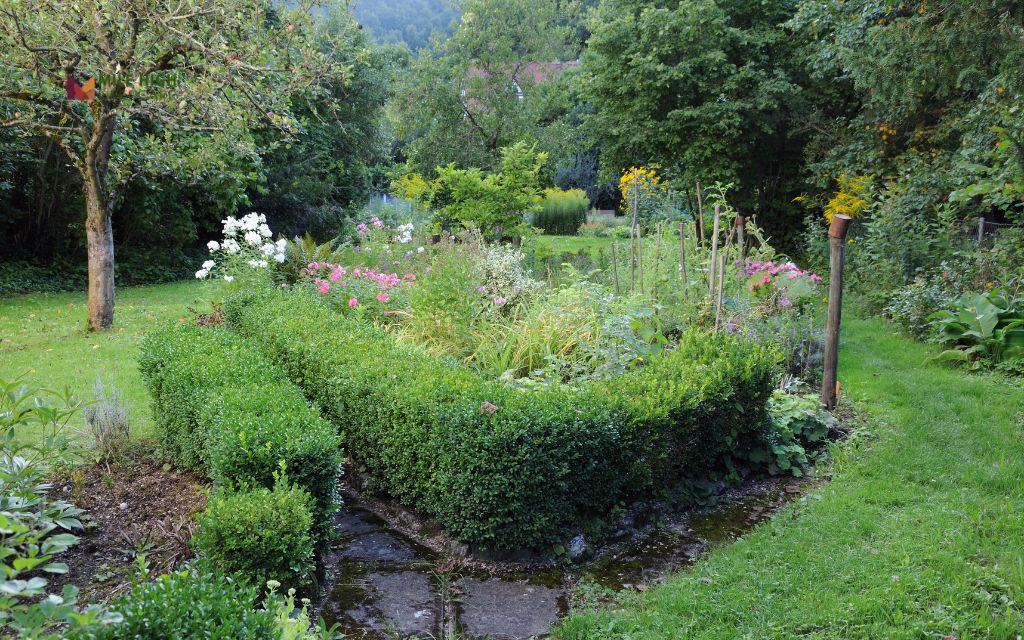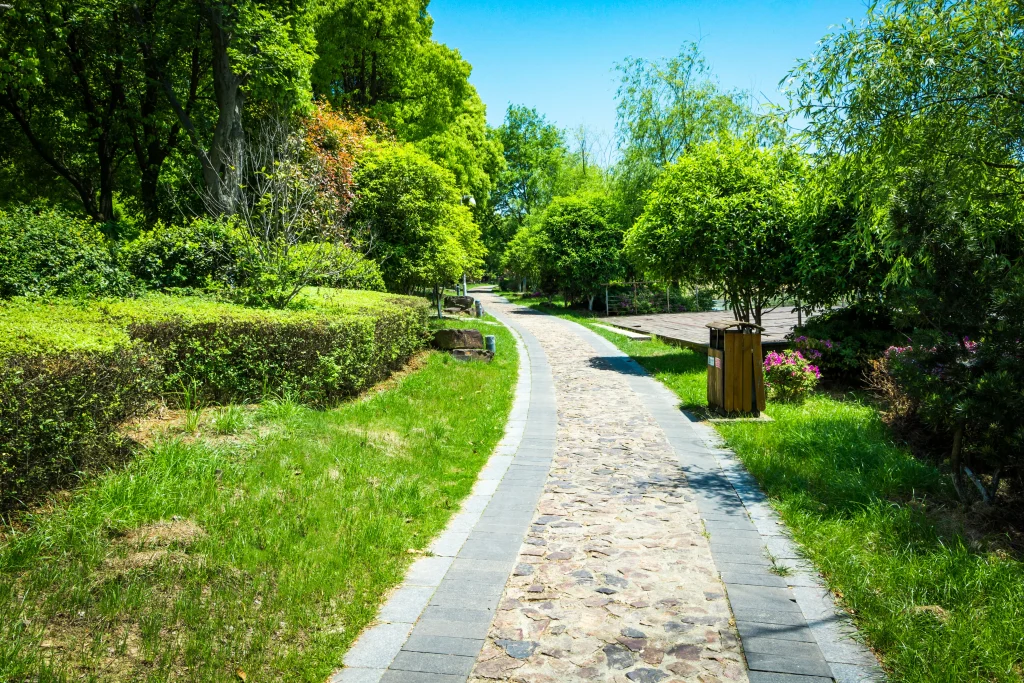The scent of lavender drifts across weathered stone paths. Roses climb white picket fences. Delphinium towers reach toward Colorado’s blue sky. This vision defines cottage garden charm, but Denver’s climate demands adaptation.
Cottage garden plans blend informal beauty with strategic plant selection. The goal centers on creating spaces that thrive in Colorado’s unique conditions while maintaining the romantic character these gardens offer. Unlike traditional English cottage gardens that rely on consistent moisture and mild temperatures, Denver designs require drought tolerance and cold hardiness.
Traditional cottage gardens evolved from English peasant plots where families grew food alongside flowers. Denver gardeners can achieve this balance by respecting altitude, embracing native species, and planning for temperature extremes.
Understanding cottage garden style
Cottage gardens began as a necessity. Medieval English workers packed vegetables, herbs, and medicinal plants into small plots near their homes. Flowers filled gaps between crops.
Over centuries, this practical approach transformed into an aesthetic movement. Victorian romantics celebrated the informal abundance, and cottage style became synonymous with natural charm.
The defining features remain consistent across regions. Dense plantings create lush tapestries where colors blend and overflow borders. Informal design rejects rigid geometry. Paths curve rather than march in straight lines. Plant heights vary throughout beds instead of following strict gradients. Seasonal variety ensures interest from spring through fall.

Planning a cottage garden in Denver
Denver sits at 5,280 feet, intensifies sunlight and reduces air pressure. Water evaporates faster from soil and leaves. Night temperatures drop even after warm days. Late spring frosts arrive in May. Early fall frosts begin in September. These realities shape every decision in cottage garden planning.
Soil preparation determines success more than any other factor. Colorado soil typically runs alkaline with clay content. Amending with compost improves drainage and adds organic matter. A three-inch layer of shredded bark mulch reduces evaporation and moderates soil temperature. Work compost into the top twelve inches before planting. Test pH and adjust toward neutral for most cottage plants.
Layout choices reflect both tradition and practicality. Position beds near the house where irrigation connects easily and you observe plants daily. Mix perennials that return each year with annuals for season-long color. Design curving paths that invite exploration while providing access for maintenance. Allow eighteen to twenty-four inches between path edges and plant stems so growth can spill naturally without blocking passage.
Step-by-step cottage garden plans
Structure forms the foundation
Start with bones that define space and support plants. Picket fences painted white or left natural create classic cottage boundaries. Lattice panels attached to posts offer vertical growing surfaces for clematis and climbing roses. Archways mark transitions between garden rooms or frame views. Trellises lean against walls or stand free to support vines.
Choose materials that age gracefully. Cedar resists rot without treatment. Willow branches woven into hurdles provide rustic charm. Metal hoops and obelisks add height without visual weight.
Design flower beds through layering
Layer plants by height to create depth while ensuring each receives adequate light. Tall specimens like delphiniums, hollyhocks, and foxgloves occupy the back of borders against fences or walls. Mid-height perennials including roses, peonies, and salvia fill the center zone. Ground covers and compact plants such as dianthus, catmint, and lady’s mantle edge paths and soften hard surfaces.
Space plants are closer than conventional wisdom suggests. Cottage style embraces crowding that mimics natural growth. This density shades soil, reduces weeds, and creates the abundant appearance that defines the aesthetic. Plan for mature sizes but accept that plants will intermingle and self-seed into unplanned arrangements.
Add pathways that invite movement
Paths serve function and beauty. Crushed gravel compacts well and drains quickly. Flagstone set in sand creates stable walking surfaces with gaps for creeping thyme. Recycled brick laid in herringbone or basketweave patterns brings warmth and texture. Decomposed granite offers a natural look that complements Colorado’s landscape.
Curve paths even in small spaces. Gentle bends create mystery and make gardens feel larger. Width matters less than continuity. A three-foot path accommodates one person comfortably and two passing carefully.
Mix plants across categories
Traditional cottage gardens rejected divisions between ornamental and edible plants. Continue this tradition by interplanting flowers with herbs and vegetables. Rosemary adds silver foliage and blue blooms. Kale contributes purple leaves. Strawberries produce white flowers before fruit. This mixing serves practical purposes in Denver’s short growing season by maximizing yield from limited space.
Native Colorado plants integrate seamlessly. Their adaptations to local conditions reduce maintenance while supporting pollinators. Blanket flower provides orange and red blooms. Penstemon spires attract hummingbirds. Rocky Mountain columbine adds delicate complexity.
Accent elements create focus
Garden furniture and decorative objects personalize cottage spaces. A weathered bench invites rest and contemplation. Birdbaths provide water for wildlife while serving as sculptural elements. Terra cotta pots clustered in corners hold tender plants or seasonal displays. Repurposed items like galvanized watering cans and wooden crates add character without requiring new purchases.
Position accents where paths intersect or views terminate. These focal points draw the eye and provide rest from visual abundance. Choose pieces that complement rather than compete with plantings.

Best plants for a Denver cottage garden
Flowers that anchor cottage style
- Roses remain essential to cottage gardens. Select disease-resistant varieties bred for cold hardiness. Knock Out series blooms continuously without deadheading. David Austin English roses offer fragrance and classic form. Shrub roses like Carefree Beauty survive winter without protection.
- Peonies thrive in Denver’s cold winters and alkaline soil. These perennials live for decades once established. Plant with eyes two inches below soil surface. Bowl-shaped blooms attract ants that help open buds.
- Delphiniums reach five to six feet when staked. Pacific Giants offer the clearest blues available in flowers. Plant in spring for summer bloom. Protect from wind and provide consistent moisture.
- Lavender tolerates drought after establishment. Phenomenal variety survives Zone 5 winters reliably. Plant in full sun with excellent drainage. Harvest stems when half the flowers open for sachets and dried arrangements.
- Dianthus provides a spicy fragrance and fringed petals. Firewitch blooms magenta and spreads to form mats. Bath’s Pink offers soft color and gray foliage. Both types prefer lean soil and resent excess moisture.
Perennials and shrubs for structure
- Echinacea withstands heat and drought while feeding pollinators. Purple coneflower represents the classic form. Newer varieties expand the palette to include orange, yellow, and white. Cut back after frost or leave seed heads for winter interest and bird food.
- Hollyhocks self-seed freely once established. These biennials produce flower spikes in their second year. Rust disease affects foliage but rarely kills plants. Accept imperfection as part of cottage garden authenticity.
- Hardy geraniums fill gaps between larger plants. Rozanne blooms from June through October with true blue flowers. Johnson’s Blue reaches eighteen inches and spreads gradually.
- Lilacs signal spring in Denver gardens. Common purple varieties reach fifteen feet but compact versions like Bloomerang stay under six feet and rebloom in fall. Plant in full sun with good air circulation.
Edibles and herbs that earn their space
- Kale tolerates frost and grows spring through fall. Lacinato leaves add texture. Red Russian provides purple stems. Both types taste sweeter after cold exposure.
- Swiss chard produces continuously when leaves are harvested from the outside. Bright Lights mix includes stems in yellow, orange, pink, and white that rival flowers for visual impact.
- Thyme survives winter as an evergreen groundcover. English thyme grows upright for easy harvesting. Creeping thyme spreads between pavers. Both types bloom in early summer.
- Sage offers silver foliage year-round. The berggarten variety resists flowering to keep leaves tender longer. Tricolor sage adds pink and white variegation.
Native Colorado options for resilience
- Penstemon species number over 250, with many native to Colorado. Rocky Mountain Penstemon tolerates clay soil and blooms purple-blue. Firecracker Penstemon attracts hummingbirds with red tubular flowers.
- Blanket flowers bloom from June until frost without deadheading. Oranges and reds provide warm tones. This species tolerates poor soil and requires no supplemental water after establishment.
- Rocky Mountain columbine serves as Colorado’s state flower. Blue and white blooms appear in May and June. Plants self-seed in partial shade and moist conditions.

Seasonal care and maintenance
Spring preparation and early planting
Begin soil preparation when ground thaws in March. Work compost into beds and refresh mulch layers. Test irrigation systems and repair any winter damage. Clean debris from paths and structures.
Plant pansies and snapdragons in early April. These cool-season annuals tolerate light frost. Transplant perennials while dormant. Direct-sow hardy annuals like larkspur and bachelor’s buttons.
Watch weather forecasts through May. Keep row cover or frost cloth ready to protect tender growth during late cold snaps. Water deeply but infrequently to encourage deep root development.
Summer irrigation and maintenance
Denver receives fifteen inches of annual precipitation. Cottage gardens require supplemental water throughout summer. Drip irrigation delivers moisture directly to root zones without wetting foliage that can encourage disease. Install timers to maintain consistent schedules.
Apply mulch in three-inch layers to reduce evaporation. Water deeply once or twice weekly rather than daily shallow watering. Morning irrigation allows foliage to dry before nightfall.
Deadhead flowers to extend bloom periods and prevent unwanted self-seeding. Roses, coneflowers, and salvia respond particularly well to regular removal of spent blooms. Leave some seed heads for birds and winter interest.
Fall cutbacks and garden renewal
September brings the first frosts. Lift tender bulbs like dahlias and gladiolus for winter storage. Cut back perennials after foliage dies or leave standing for winter structure. Seed heads and dried stems provide food and shelter for wildlife.
Add finished compost to beds before winter. Mulch around perennials after the ground freezes to prevent heaving during temperature fluctuations.
Collect and clean seeds from favorite annuals. Store in paper envelopes in a cool, dry location. Many cottage garden plants self-sow, but collecting seed ensures you can replant in desired locations.
Winter protection and planning
Protect marginally hardy roses and shrubs with burlap screens that block wind without creating excessive warmth. Avoid wrapping trunks with plastic that traps moisture and encourages disease.
Water evergreens monthly during dry winters when temperatures rise above 40 degrees. These plants continue transpiring moisture through winter but cannot replace it from frozen ground.
Review the season’s successes and failures. Order seeds and plants in January for spring delivery. Sketch modifications to improve next year’s display.
Example Denver cottage garden plan
This sample 20×20 foot garden demonstrates cottage principles adapted for Colorado conditions. The plan assumes full sun and moderate soil amended with compost.
Structural elements
A white picket fence defines the back and side boundaries. The fence stands four feet high to support climbing roses without blocking views or feeling imposing. An arbor marks the main entrance on the south side. Paths of decomposed granite curve through the space in informal loops that connect all planting areas.
Planting zones
Zone 1: Back border (North exposure against fence)
Plant three David Austin roses at five-foot intervals trained to fence supports. Fill gaps with delphinium Pacific Giants in groups of three. Edge with catmint that tolerates shade from larger plants and provides purple-blue flowers from June through September.
Zone 2: Central island bed
Anchor the center with a single peony, preferably a fragrant double like Sarah Bernhardt. Surround with four echinacea in mixed colors. Plant six lavender Phenomenal around the bed’s perimeter. This arrangement creates a symmetrical focal point while maintaining informal plantings.
Zone 3: South border (full sun near path)
Install three hollyhocks for vertical accent. Plant blanket flower between hollyhocks for continuous color. Edge with dianthus Firewitch for fragrance and ground coverage. This south-facing exposure handles Denver’s intense sun and suits drought-tolerant selections.
Zone 4: East corner (morning sun, afternoon shade)
Plant Rocky Mountain columbine beneath the arbor where morning light supports blooming but afternoon shade prevents stress. Add hardy geranium Johnson’s Blue for extended color after columbine finishes. Include lady’s mantle for chartreuse flowers and architectural foliage.
Zone 5: West corner (full sun, hottest exposure)
Position Russian sage for silver foliage and late-summer purple flowers. Plant penstemon Firecracker at the base. Add ornamental grasses like blue oat grass for movement and texture. This combination handles heat without supplemental water after establishment.
Accent placement
Position a small bench on the north side facing south for warm afternoon rest. Install a birdbath in the central bed slightly off-center from the peony. Place three terra cotta pots near the arbor for rotating displays of annuals and herbs.
This plan provides structure while allowing flexibility. Adjust plant numbers based on mature sizes and personal preferences. The framework supports adaptation as plants establish and reseed into unplanned arrangements.
Conclusion
Cottage gardens succeed in Denver when planning respects climate while embracing the style’s informal spirit. Start with soil preparation and structural elements. Select plants for both beauty and resilience. Accept that gardens evolve through seasons and years as plants self-seed and spread.
Your cottage garden can reflect personal taste while serving Colorado’s ecosystem. Native plants support pollinators. Herbs provide harvests. Flowers feed the soul through color and fragrance. These benefits combine in spaces that feel both intentional and discovered.
Mile High Lifescape offers personalized planning services to help Denver homeowners create landscapes that combine charm with practicality. Contact us at (303) 877-9091 or hello@milehighlifescape.com to discuss your vision.
Frequently asked questions (FAQs)
How to plan a cottage style garden?
Planning begins with site analysis. Measure your space and note sun exposure throughout the day. Test soil pH and drainage. Sketch a layout showing paths, beds, and focal points. Select a mix of perennials and annuals. Layer plants by height with tall specimens at the back and ground covers at the front. Include vertical elements like trellises and arbors. In Denver, focus on drought-tolerant species that survive winter temperatures. Amend soil with compost before planting. Install drip irrigation for consistent moisture. Plan for wind protection in exposed sites.
What is the rule of 3 in landscaping?
The rule of 3 states that odd-numbered groupings create more visual interest than even numbers. Plant in groups of three, five, or seven rather than pairs or fours. Odd numbers prevent the eye from pairing items, creating more dynamic compositions. Apply this rule when repeating the same species in a border. Three delphiniums create impact without monotony. Five echinacea establish an intentional drift. The rule extends to color repetition and structural elements throughout the garden.
What makes a garden a cottage garden?
Cottage gardens blend informal design with abundant planting. Key characteristics include dense layering where plants overflow boundaries, curving paths, and mixed plantings that combine flowers, herbs, and vegetables. Traditional elements like picket fences and rose arbors establish cottage style. However, the overall feeling of lush, casual abundance matters more than specific features. Self-seeding and natural spread contribute to the authentic look. In Denver, cottage gardens adapt traditional elements to local conditions through drought-tolerant perennials and native species integration.
How to design an old fashioned cottage garden?
Old fashioned cottage gardens prioritize heritage plants that predate modern hybrids. Heirloom roses offer fragrance, single-form flowers attract pollinators, and herbs serve culinary purposes beyond decoration. Design around practical elements. Position beds near the kitchen door for easy harvest. Include seating areas and use salvaged materials as garden features. Select plants that self-seed and naturalize like forget-me-nots, foxgloves, and love-in-a-mist. In Denver, choose heritage varieties proven in high-altitude gardens. Consult local nurseries for heirloom seeds adapted to Colorado conditions.
